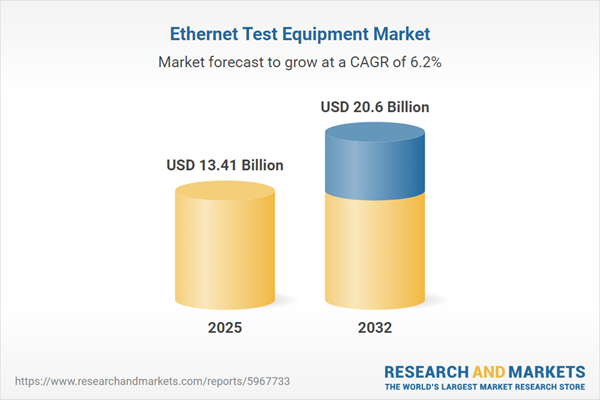Speak directly to the analyst to clarify any post sales queries you may have.
Ethernet test equipment is pivotal for organizations seeking to ensure seamless connectivity, high-speed data transfer, and secure operations across evolving digital infrastructures. As the backbone of network validation in diverse industries, this market enables robust performance, regulatory compliance, and accelerated rollouts of emerging technologies.
Market Snapshot: Ethernet Test Equipment Market Growth
The Ethernet test equipment market is witnessing resilient expansion, driven by accelerating investments in high-speed networks, migration to virtualized environments, and increasing complexity across global IT and telecommunications infrastructures. Heightened demand stems from both established enterprises modernizing legacy systems and new entrants deploying next-generation platforms. Industry momentum is sustained by ongoing regulatory shifts, rapid technology adoption, and the need for ever-stringent performance assurance and network security standards.
Scope & Segmentation
- Product Types: Network protocol analyzers, physical layer testers, switch and router test equipment, network configuration management software, network monitoring software, performance analysis tools, end-to-end solutions, and standalone solutions
- Technology Focus: 5G network trial and standalone architecture testing, IoT device analysis and network performance validation, Network Function Virtualization (NFV), and Virtual Network Function (VNF) testing
- Testing Frequency: Automated continuous testing, real-time monitoring, ad-hoc and scheduled network validation
- Applications: Data center network management, server performance monitoring, corporate network security testing, private cloud infrastructure testing, fixed broadband and mobile network service validation
- End Users: Government agencies, public safety networks, military communication, Internet service providers, satellite internet providers, fixed-line and mobile telecom companies
- Regions: Americas (North and Latin America), Europe, Middle East, Africa, and Asia-Pacific (including major economies such as the United States, Germany, China, and Japan, as well as emerging markets)
Key Takeaways for Decision-Makers
- The Ethernet test equipment market enables organizations to adapt to evolving network protocols, such as seamless transitions from established systems to advanced high-speed architectures.
- Continuous adoption of virtualization, software-defined networking, and IoT requires robust, agile validation platforms to manage increasing data traffic and device proliferation.
- Global deployment and maintenance strategies now hinge on modular solutions, enabling flexible support across hardware, software, and hybrid environments.
- Regional regulatory compliance, infrastructure maturity, and local deployment timelines are directly shaping investment patterns and supplier requirements.
- Industry leaders are advancing through R&D, alliances with vendors, open architecture integration, and tailored service programs catering to local market nuances.
Tariff Impact on Ethernet Test Equipment Supply Chains
Recent tariff initiatives in the United States have introduced cost pressures across Ethernet test equipment supply chains, increasing procurement challenges for critical components such as semiconductors and licensed modules. Companies are responding by optimizing inventory strategies, strengthening partnerships in free trade zones, and accelerating adoption of automation to offset rising operational expenses. Diversified sourcing and local assembly are now essential for supply resilience and margin protection, prompting vendors to revisit global procurement frameworks and workflow methodologies.
Primary Keyword Focus: Ethernet Test Equipment Market
The Ethernet Test Equipment Market is central to enabling reliable, high-speed, and future-ready network infrastructures. Senior decision-makers recognize that investment in advanced test platforms reduces service downtime and accelerates deployment of mission-critical digital services. Demand remains robust as organizations adapt to software-driven networks, increasing regulatory scrutiny, and rapid technology cycles.
Methodology & Data Sources
This report utilizes a rigorously structured research approach, combining quantitative and qualitative methods. Primary sources include executive interviews and consultations with product managers and procurement leaders. Extensive secondary research is conducted by analyzing technical papers, regulatory filings, and competitive benchmarks. Data is validated through triangulation and expert peer review, ensuring credibility and actionable insights.
Why This Report Matters
- Provides stakeholders with targeted recommendations for optimizing testing investments in response to evolving technologies and shifting global trade landscapes.
- Offers comprehensive segmentation and regional intelligence to support risk mitigation, supplier selection, and product development strategies.
- Delivers actionable competitive analysis, revealing strategic collaboration trends and market positioning among leading vendors.
Conclusion
As digital infrastructures grow in complexity and scale, agile and comprehensive Ethernet test solutions remain vital for sustained reliability and performance. Organizations able to adapt, innovate, and optimize testing frameworks will be well-positioned to address current demands and future challenges.
Additional Product Information:
- Purchase of this report includes 1 year online access with quarterly updates.
- This report can be updated on request. Please contact our Customer Experience team using the Ask a Question widget on our website.
Table of Contents
3. Executive Summary
4. Market Overview
7. Cumulative Impact of Artificial Intelligence 2025
Companies Mentioned
The companies profiled in this Ethernet Test Equipment market report include:- Accedian Networks Inc.
- Anritsu Corporation
- Asian Contec Ltd
- Beijing Xinertel Technology Co. Ltd.
- EXFO Inc.
- Fluke Corporation
- GAO Group Inc.
- GL Communications Inc.
- IDEAL INDUSTRIES Inc.
- Keysight Technologies, Inc.
- Marvell Technology Inc.
- NetAlly, LLC
- NetScout Systems Inc.
- NWS
- Rohde & Schwarz Benelux B.V.
- Sifos Technologies Inc.
- Silvertel
- Spirent Communications plc
- TE Connectivity Ltd.
- Tektronix
- Teledyne Technologies Inc.
- VeEX Inc.
- Viavi Solutions Inc.
- Yokogawa Electric Corp.
Table Information
| Report Attribute | Details |
|---|---|
| No. of Pages | 190 |
| Published | November 2025 |
| Forecast Period | 2025 - 2032 |
| Estimated Market Value ( USD | $ 13.41 Billion |
| Forecasted Market Value ( USD | $ 20.6 Billion |
| Compound Annual Growth Rate | 6.2% |
| Regions Covered | Global |
| No. of Companies Mentioned | 25 |









